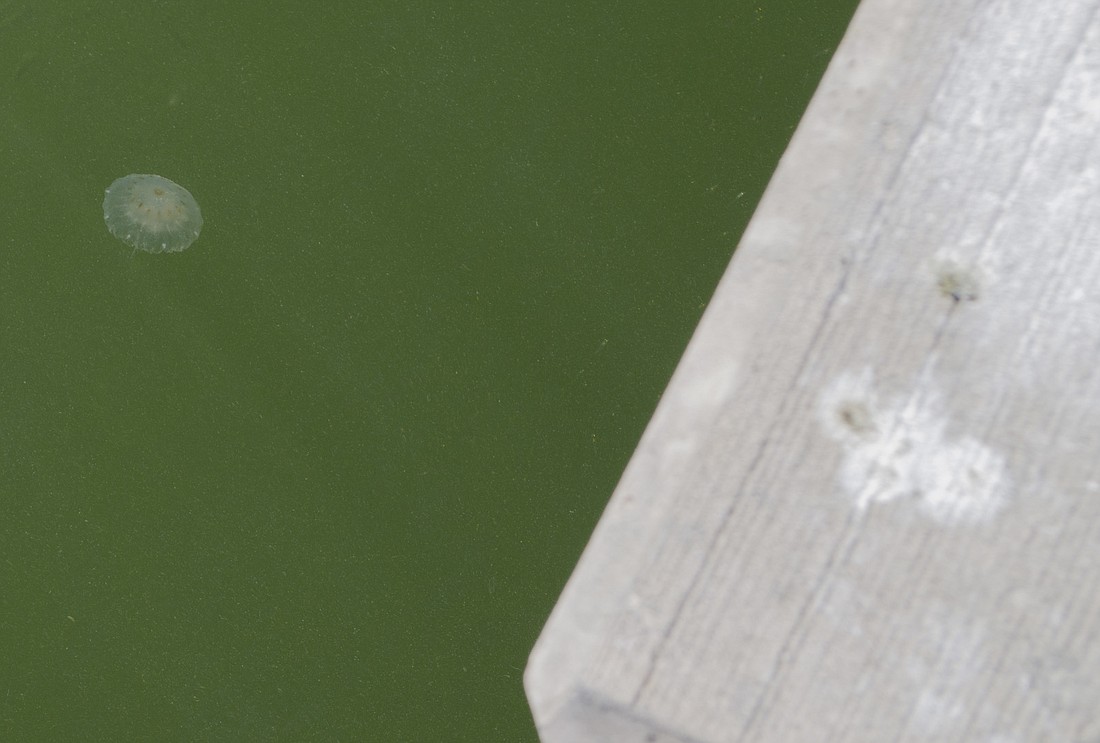- April 24, 2025
-
-
Loading

Loading

Hundreds of triathletes gathered at The Resort at Longboat Key Club last month prepared to run, cycle and swim their way to victory.
But the morning of Oct. 14, and the Gulf of Mexico, had other plans.
That’s because the lagoon at The Resort at Longboat Key Club was filled with jellyfish. They’ve been washing up along beaches as well.
Most of them are Atlantic sea nettles ranging from four and eight inches in diameter, said Andrew Angelo, a jellyfish specialist and biologist at Mote Marine Laboratory and Aquarium.
These animals can grow to longer than one-and-a-half feet and more than nine inches in diameter, have a brown striation around their bells and a brown spot in the center, “almost like a bull’s-eye,” Angelo said.
Although these squishy invertebrates are often prevalent in late summer and early fall, Angelo said this year’s smack — the technical term for a group of jellyfish — is unique.
“I’ve never seen them as prominent as they’ve been this season,” said Angelo, who’s spent seven years at Mote.
But he said he’s not sure why there are so many this year.
It could be the storm surge from Hurricane Irma, which disturbed and suspended nutrient rich material in the water column along the coast: food that attracts zooplankton — Atlantic sea nettle’s main source of food, Angelo said.
Those storm surges could have also brought the jellyfish toward the shore — these gelatinous creatures do not move on their own but rather with the currents, Angelo said.
The Gulf of Mexico is also at a much lower salinity — or salt concentration — than normal, Angelo said. This is an ideal climate for Atlantic sea nettle jellies, allowing them to reproduce at a higher rate than if salinity numbers were higher, Angelo said.
It could also have something to do with global jellyfish numbers. Jellyfish populations swell and slough over a period of years.
Angelo said he hasn’t seen literature about growing Atlantic sea nettle smacks, but it could be a reason for the increase in population along Longboat Key.
But one thing is certain, these jellyfish can be harmful, Angelo said.
Although everyone reacts differently to jellyfish venom — released when an object touches its tentacles – Angelo said when he gets stung by an Atlantic sea nettle it feels like a bee sting. He said this immediate painful sensation, for him, can last anywhere between 45 minutes and two hours.
Some people might have a stronger reaction and others may not feel the sting at all, Angelo said, but it all depends where on the body the jellyfish tentacle touches. Angelo said jellyfish stings are most painful in sensitive areas, like the underside of his arm.
This pain comes from tiny spear-like structures that line the jellyfish’s tentacles called cnidocytes. These explosive cells, which look like an “inside-out sock with a harpoon in it,” Angelo said, have a hair-like trigger that allow them to project a venom-filled barb, called a cnida, within microseconds.
The reaction is mechanical, meaning the energy used to release the cnida is contained within the cell and active even after the animal has died, Angelo said. That means jellyfish can sting even once they’ve washed up on the beach.
The best way to avoid a jellyfish sting is simple: Don’t go in the water. But braver sorts may wear a rashguard or shirt, which are often thick enough to stop the jellyfish sting before it reaches skin.
Wearing protective covering could be counterproductive, however — if a jellyfish gets inside a shirt or rash guard, it could be difficult, and painful, to get out, Angelo said.
And it’s really a guessing game as far as when these jellies might leave, Angelo said. He said it all comes down to tides, winds and currents.
“Your guess is as good as mine,” Angelo said.